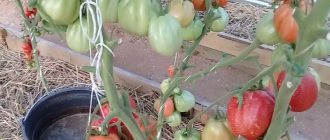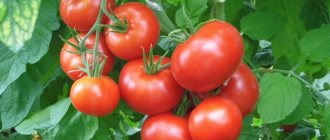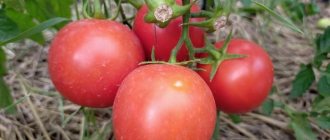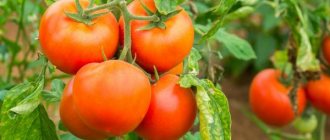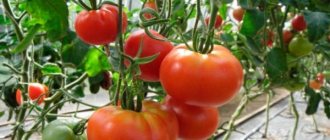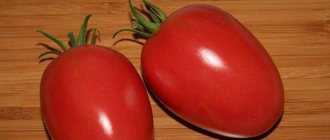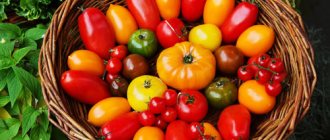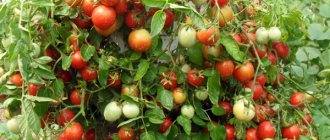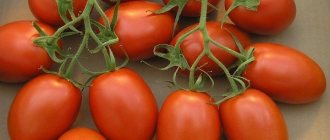Characteristics and description of the tomato variety My Love
Tomato My Love F1 is a hybrid that combines the best qualities. The plant is determinate, independently limits growth above the 5th inflorescence, grows up to 0.8 m in height in open ridges and up to 1.2 in a greenhouse. The leaves are dark green, medium in size, small foliage. Few stepsons are formed on the bush, which makes it possible to grow tomatoes without removing them.
The hybrid has early ripening periods; 85-90 days pass from germination to the appearance of the first tomatoes. Tomato variety My Love F1 is intended for cultivation in greenhouses and open ground.
The fruits are red, round, with a decorative spout. Under unfavorable growing conditions, elongation may not appear. The tomatoes are formed in clusters, all the fruits are aligned, ripen together, and do not crack. The weight of one tomato is 150-200 g.
How to grow
Let's look at the features of growing tomatoes My Love.
Soil requirements
Prepare the soil for planting by digging it up and loosening it. If the soil is compacted, add a little sand or peat to it. Acidic soil is mixed with dolomite flour or chalk, or lime is added to it (once every 3 years).
Reference! Sprinkle the seedlings with fluffy soil rich in oxygen. It is prepared in advance, before planting.
Sowing rules
Seeds are planted from mid-March to early April. The land is prepared and fertilized in advance.
The largest and strongest specimens are selected from the packaging. To increase germination, they are soaked in a growth stimulator. Some vegetable growers wash grains with a solution of potassium permanganate to prevent fungal diseases and destroy traces of pests. However, the hybrid planting material has already undergone the necessary processing by the manufacturer.
When the seeds hatch and the first 2 leaves appear, the plants are planted in separate containers. The strongest seedlings are selected. After 2 months (late May-early June), the seedlings are planted in open ground. Before this, they are hardened in the fresh air for better adaptation to new conditions.
When growing tomatoes in a greenhouse, sowing is carried out already in early March. Such seedlings will give a good harvest by the end of June.
Planting holes are dug 40 cm apart, the distance between rows is 70 cm. There should not be more than 3 plants per 1 m2. Fertilizers with the elements necessary for the crop are placed in the pits: potassium, nitrogen, phosphorus. The holes are made at least 20 cm deep: they should be larger than the rhizome, which will ensure high-quality picking of plants.
Care after transplant
To grow a good harvest, the crop is properly cared for throughout the summer:
- water at least once every 5 days;
- tie the bushes to a support;
- weed the beds, remove weeds and loosen the soil between the rows;
- prevent plant diseases;
- stepsons are removed;
- feed tomatoes.
Despite the fact that the hybrid tolerates temperature changes and drought well, in the first weeks after planting in open ground it needs to be covered with film.
Pinching bushes in a greenhouse ensures the fastest ripening of fruits. In open ground, plants have a stronger stem, so tying it and supporting the branches is not necessary. In ground tomatoes, garters and supports can significantly slow down and prolong the process of fruit ripening.
When cultivating a hybrid in central Russia in open ground, the seedlings are covered with film during the first month after planting. Afterwards it is removed. In the northern regions, the crop is grown only in greenhouse conditions.
The My Love tomato is quite unpretentious in watering and tolerates drought with restraint. Warm water is used for irrigation. Water once every 5 days, in the evening. A day after the soil is moistened, it is loosened and weeded.
Phosphorus and potassium supplements are very important for fruit ripening. They fertilize the bushes at every stage of growth. In the future, they switch to complex formulations. Mulching the soil increases productivity and reduces the frequency of loosening the beds.
Tomato clusters, as a rule, form on 7–9 leaf axils. To obtain the desired shape of the fruit, the stepson is left under these clusters: a second stem will form from it. Subsequent stepsons that grow to 6–8 cm are cut off in time.
Attention! When removing the stepson, a small “stump” of 0.5 cm is left to avoid the emergence of a new shoot in this place.
Pros and cons of the tomato variety My Love
The hybrid of Russian selection was bred taking into account climatic conditions and is approved for cultivation in all regions. The advantages also include the excellent taste of the fruit and early ripening. Tomatoes of the My Love F1 variety manage to ripen before the massive spread of late blight and have a universal purpose.
Important! The low-growing hybrid My Love F1 does not require mandatory formation, so this simplified cultivation is especially suitable for beginner gardeners.
The disadvantages of the variety include a small number of fruits, but taking into account the type of growth, the yield of the My Love F1 tomato is high. Another feature of the hybrid, unlike the variety, is the impossibility of re-growing the plant from its own seeds. But the hybrid is more resistant to adverse weather conditions and pathogenic microflora.
Optimal growing conditions
Tomato My Love F1 is suitable for growing in all types of greenhouses, as well as film shelters. The bush can be grown without staking and pinching. It is preferable to place tomato seedlings on high ridges, which will allow for even earlier production and protect the plant’s root system from temperature changes.
Tomatoes need good lighting, but on hot sunny days it is necessary to have the possibility of shading both in open ground and in a greenhouse.
The soil for plants should be fertile, loose, free of foreign matter and weeds. The soil in the greenhouse must be periodically replaced with new one or disinfected. In open ground, crop rotation is observed; it is best to plant the crop after legumes, root crops and green manures such as mustard and alfalfa.
Reviews from gardeners
Marina, Rostov-on-Don: “I use the fruits of this hybrid for preservation. Pleasant sourness and strong peel are perfect for a winter snack. As for cultivation, I personally like that the bushes do not stretch, only about 70 cm. I grow them in open ground. After transplantation, in the first weeks, I cover it with film and feed it. The bushes have significant foliage and fairly dense branching. On average, up to 5 brushes are formed on each, with 5-6 ovaries in each. The fruits are beautiful, as in the photo, round in shape, smooth, and do not crack. Ripening time is early: about 3 months.”
Svetlana, Belgorod: “ For the third season now, I have been focusing on the seeds of this hybrid. The description and characteristics on the packaging almost completely coincide with the real result. The most important thing is not to be late with planting dates, as this will ensure exceptional taste. Once I made a mistake with planting - the tomatoes were a little brown and were ripening in a box on the shelf.”
Tamara, St. Petersburg: “As a beginning vegetable grower, I bought these seeds for planting in a new greenhouse; not all of them sprouted, but I had enough seedlings. They tried, weeded, watered, fed with simple fertilizers. I can’t say anything special about leaving. I don’t know how to trim branches, so I tied them up instead. We waited about 3 months for the harvest. The fruits grew large and round with a small pimple at the end. The tomatoes are aromatic and tender, I really liked them. Next year I’ll plant them again.”
Growing
Tomato My Love F1 is grown through seedlings. Before transplanting, tomatoes are grown for 50-55 days and then transplanted into warm soil. Therefore, the date of sowing seeds depends on the climate in the growing region and the location of transplantation.
Growing seedlings
Sowing of seeds is carried out in previously prepared soil. It is best to use self-prepared soil or improve the finished substrate.
The soil mixture is prepared from fertile soil, loosened with rotted sawdust or river sand, and lime and ash are added. Any soil for disinfection is spilled with fungicide solutions.
Beneficial bacteria are also added to the soil to keep it alive. It is necessary to mix the elements in advance so that they interact.
For cultivation, use common or separate containers. They are also disinfected before planting. The soil substrate is distributed into containers, leveled and watered. When sowing in separate cassettes, the seeds are placed several in one container. In common containers they are distributed with a distance of several centimeters from each other and 4-5 cm between sowing lines.
After laying out the seeds, they are covered with a 1 cm layer of soil. Depending on the temperature in the room, they are covered with film or germinated without it. As soon as the seedling loops begin to emerge from the ground, the planting containers are immediately placed under a special light. It is important not to miss this moment, because at this time plants lay down information for further development.
Advice! Lighting of seedlings in the first few days after emergence is left around the clock, then reduced to 12-14 hours, depending on the amount of natural light.
At the stage of several true leaves, the Moya Lyubov F1 tomato is planted in larger containers with a volume of about 0.5 liters. The determinate type of tomatoes has shorter and stockier seedlings, in contrast to tall varieties. Before planting, the plants are hardened off for about a week.
Landing rules
Plants are replanted from the moment night air temperatures rise above +10º C and the soil warms up to the depth of the root system. Plants develop well at soil temperatures of +21°C.
Plants are planted according to a scheme where a distance of 40 cm is maintained between bushes, and 50 cm between rows. The distance is calculated from the base of the bush. In open ground, planting can be done more frequently than in a greenhouse.
Transplant the seedlings, preserving the earthen ball, into a previously prepared hole. The planting hole is thoroughly watered and fertilizers are applied. Replant plants at the same soil level as they grew previously.
Watering and fertilizing
The My Love F1 tomato requires even watering throughout the entire growing season. In protected soil, it is best to water plants in the morning, so that the soil and air have time to dry out during the day.
For watering, use warm water, which is poured into the root zone with a watering can without a diffuser so that water and splashes do not fall on the plant. A drip irrigation system is preferred.
Advice! During the growing season, a tomato needs 3-4 fertilizing, which alternates with application at the root and along the leaves.
The first fertilizing in open ground is carried out 1-1.5 weeks after transplantation. Due to the early ripening of fruits, it is best to fertilize with organic fertilizers, for example, infusions of mullein, ash and grass.
Pinching and tying
Tomato My Love F1 can be grown with or without pinching. The strongest stepsons are formed first in the lower part of the plant. If they are removed, the fruits will ripen earlier and will be larger; if the side shoots are left, the yield will be higher.
The low-growing plant can be grown without a garter. But the garter allows the bushes to be well ventilated and receive enough light. Also, to prevent the stems from breaking under the weight of the fruit, the central trunk and brushes are tied to a trellis, wrapping the plant with twine with moderate tension.
Formation
Tomato My Love F1 has a determinant growth type and does not require shaping. It finishes its growth on its own with a flower brush, so it should not be topped up. As the plant develops, remove the lower leaves so that they do not come into contact with the soil and neighboring plants.
Protection from diseases and pests
In order to increase the crop's resistance to diseases, solutions of humates are used, which are sprayed on tomato bushes of the My Love F1 variety in the phase of bud formation and flowering.
Periodic spraying is carried out with fungicidal preparations, including on the soil. The hybrid manages to escape from a dangerous tomato disease - late blight - because it yields the crop early. Phosbecid is used against pests.
Bush care
The agricultural technology for growing the “My Love” tomato is quite simple and involves the following activities:
- Watering. Plants need shallow watering every 3-7 days depending on climate conditions. During periods of drought, water more often; in cool weather, less often. 20 days before harvest, watering is stopped;
- Mulching. Used to retain moisture in the ground. Shredded straw or sawdust is used as mulch, covering the bed with 15-20 cm of it. Another useful property of mulch is inhibition of weed growth;
- Feeding. The first feeding is carried out 10 days after planting the seedlings. Ammonium sulfate is diluted in a concentration of 2 tablespoons per bucket of water and distributed evenly around the perimeter of the bed. Further feeding is carried out at intervals of 7 days. When fertilizing, you need to adhere to the correct ratio of calcium and potassium fertilizers, which should be 1:3;
- Loosening. This is carried out regularly to avoid hardening of the top layer of soil. In dry weather, the soil is loosened superficially.
